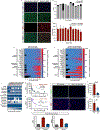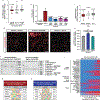A phenotypic screening platform for identifying chemical modulators of astrocyte reactivity
- PMID: 38378993
- PMCID: PMC11034956
- DOI: 10.1038/s41593-024-01580-z
A phenotypic screening platform for identifying chemical modulators of astrocyte reactivity
Abstract
Disease, injury and aging induce pathological reactive astrocyte states that contribute to neurodegeneration. Modulating reactive astrocytes therefore represent an attractive therapeutic strategy. Here we describe the development of an astrocyte phenotypic screening platform for identifying chemical modulators of astrocyte reactivity. Leveraging this platform for chemical screening, we identify histone deacetylase 3 (HDAC3) inhibitors as effective suppressors of pathological astrocyte reactivity. We demonstrate that HDAC3 inhibition reduces molecular and functional characteristics of reactive astrocytes in vitro. Transcriptional and chromatin mapping studies show that HDAC3 inhibition disarms pathological astrocyte gene expression and function while promoting the expression of genes associated with beneficial astrocytes. Administration of RGFP966, a small molecule HDAC3 inhibitor, blocks reactive astrocyte formation and promotes neuroprotection in vivo in mice. Collectively, these results establish a platform for discovering modulators of reactive astrocyte states, inform the mechanisms that control astrocyte reactivity and demonstrate the therapeutic benefits of modulating astrocyte reactivity for neurodegenerative diseases.
© 2024. The Author(s), under exclusive licence to Springer Nature America, Inc.
Conflict of interest statement
Figures














References
MeSH terms
Grants and funding
LinkOut - more resources
Full Text Sources
Medical
Molecular Biology Databases

